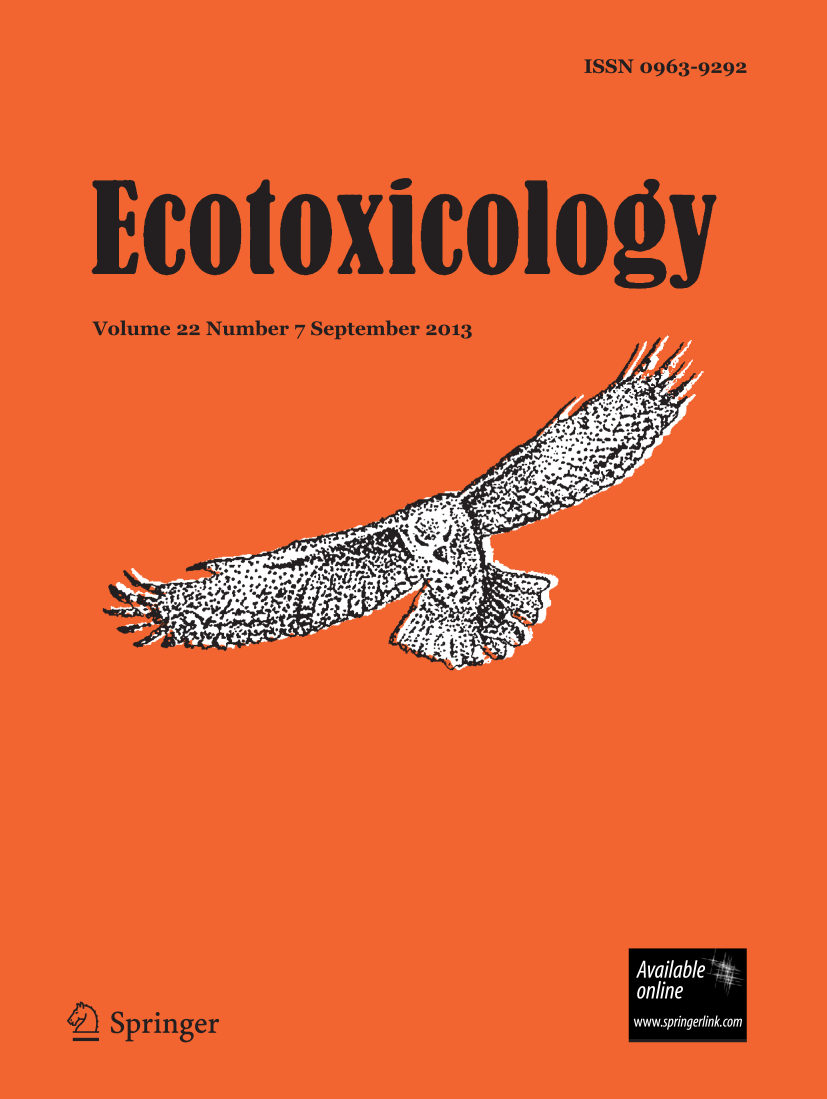Nanoparticles-mediated entomotoxicology: lessons from biologica.
Lamia M El-Samad, Nahed R Bakr, Mohamed Abouzid, Eslam S Shedid, John P Giesy, Shaden A M Khalifa, Hesham R El-Seedi, Abeer El Wakil, Yahya Al Naggar
求助PDF
{"title":"Nanoparticles-mediated entomotoxicology: lessons from biologica.","authors":"Lamia M El-Samad, Nahed R Bakr, Mohamed Abouzid, Eslam S Shedid, John P Giesy, Shaden A M Khalifa, Hesham R El-Seedi, Abeer El Wakil, Yahya Al Naggar","doi":"10.1007/s10646-024-02745-z","DOIUrl":null,"url":null,"abstract":"<p><p>Nanotechnology has grown in importance in medicine, manufacturing, and consumer products. Nanoparticles (NPs) are also widely used in the field of insect pest management, where they show a variety of toxicological effects on insects. As a result, the primary goal of this review is to compile and evaluate available information on effects of NPs on insects, by use of a timely, bibliometric analysis. We also discussed the manufacturing capacity of NPs from insect tissues and the toxic effects of NPs on insects. To do so, we searched the Web of Science database for literature from 1995 to 2023 and ran bibliometric analyses with CiteSpace<sup>©</sup> and Bibliometrix<sup>©</sup>. The analyses covered 614 journals and identified 1763 relevant documents. We found that accumulation of NPs was one of the top trending topics. China, India, and USA had the most published papers. The most overall reported models of insects were those of Aedes aegypti (yellow fever mosquito), Culex quinquefasciatus (southern house mosquito), Bombyx mori (silk moth), and Anopheles stephensi (Asian malaria mosquito). The application and methods of fabrication of NPs using insect tissues, as well as the mechanism of toxicity of NPs on insects, were also reported. A uniform legal framework is required to allow nanotechnology to fully realize its potential while minimizing harm to living organisms and reducing the release of toxic metalloid nanoparticles into the environment.</p>","PeriodicalId":11497,"journal":{"name":"Ecotoxicology","volume":" ","pages":"305-324"},"PeriodicalIF":2.4000,"publicationDate":"2024-04-01","publicationTypes":"Journal Article","fieldsOfStudy":null,"isOpenAccess":false,"openAccessPdf":"","citationCount":"0","resultStr":null,"platform":"Semanticscholar","paperid":null,"PeriodicalName":"Ecotoxicology","FirstCategoryId":"93","ListUrlMain":"https://doi.org/10.1007/s10646-024-02745-z","RegionNum":4,"RegionCategory":"环境科学与生态学","ArticlePicture":[],"TitleCN":null,"AbstractTextCN":null,"PMCID":null,"EPubDate":"2024/3/6 0:00:00","PubModel":"Epub","JCR":"Q2","JCRName":"ECOLOGY","Score":null,"Total":0}
引用次数: 0
引用
批量引用
Abstract
Nanotechnology has grown in importance in medicine, manufacturing, and consumer products. Nanoparticles (NPs) are also widely used in the field of insect pest management, where they show a variety of toxicological effects on insects. As a result, the primary goal of this review is to compile and evaluate available information on effects of NPs on insects, by use of a timely, bibliometric analysis. We also discussed the manufacturing capacity of NPs from insect tissues and the toxic effects of NPs on insects. To do so, we searched the Web of Science database for literature from 1995 to 2023 and ran bibliometric analyses with CiteSpace© and Bibliometrix© . The analyses covered 614 journals and identified 1763 relevant documents. We found that accumulation of NPs was one of the top trending topics. China, India, and USA had the most published papers. The most overall reported models of insects were those of Aedes aegypti (yellow fever mosquito), Culex quinquefasciatus (southern house mosquito), Bombyx mori (silk moth), and Anopheles stephensi (Asian malaria mosquito). The application and methods of fabrication of NPs using insect tissues, as well as the mechanism of toxicity of NPs on insects, were also reported. A uniform legal framework is required to allow nanotechnology to fully realize its potential while minimizing harm to living organisms and reducing the release of toxic metalloid nanoparticles into the environment.
纳米颗粒介导的昆虫毒理学:从生物科学中汲取的经验教训
纳米技术在医药、制造和消费品领域的重要性与日俱增。纳米粒子(NPs)也被广泛应用于昆虫害虫管理领域,对昆虫产生各种毒理影响。因此,本综述的主要目的是通过及时的文献计量分析,汇编和评估有关纳米粒子对昆虫影响的现有信息。我们还讨论了从昆虫组织中制造 NPs 的能力以及 NPs 对昆虫的毒性效应。为此,我们在科学网数据库中搜索了 1995 年至 2023 年的文献,并利用 CiteSpace© 和 Bibliometrix© 进行了文献计量分析。分析涵盖了 614 种期刊,确定了 1763 篇相关文献。我们发现,氮磷的积累是最热门的话题之一。中国、印度和美国发表的论文最多。报道最多的昆虫模型是埃及伊蚊(黄热病蚊子)、库蚊(南方家蚊)、蚕蛾(蚕蛾)和按蚊(亚洲疟蚊)。此外,还报告了利用昆虫组织制造 NPs 的应用和方法,以及 NPs 对昆虫的毒性机理。需要建立统一的法律框架,使纳米技术充分发挥其潜力,同时最大限度地减少对生物体的伤害,并减少有毒金属纳米粒子向环境的释放。
本文章由计算机程序翻译,如有差异,请以英文原文为准。


